|
|||||||||||||||
|
The History of the England Programme In the early days, it
was the host club that was responsible for producing the
match programmes. It would have just been another edition for their
editor. It's unlikely that there would have been any
In 1963, for the FA's centenary, the emblem, at last, appeared on the cover, still with aerial views of the stadium, but now different views. Then, for the 1964-65 season, action shots from previous Wembley games featured, including, curiously, the 1963 FA Cup Final for the Belgium game! Unfortunately, the emblem disappeared from the cover, and was replaced by a Tudor rose for the Home Internationals. There was a brief revival of the old-style aerial shots in the run-up to the 1966 World Cup. The Football Association's World Cup Organisation produced a programme for the whole tournament using the same printers as Wembley had for their programmes. All 16 squads were listed, plus the referees, and there was space for readers to add in the details for all 32 matches. Interestingly, the spaces for each line-up ordered them by position in the old-fashioned form of Right Half-Back, Inside Right, Centre Forward etc., as if teams were going to play as if they were numbered 1-11 in the traditional 2-3-5 formation, when all would be wearing squad numbers and England themselves would be playing in a 4-4-2 formation. So, not so easy to align to each position. The 72 pages included the late addition of a four-page insert, announcing the sudden death, just ten days before the start of the tournament, of Joe Mears, the FA's chairman, who had written a welcome message for the programme. The other three extra pages were left blank, though two of them had been headed 'Notes'. Only one individual match programme was produced, at 66 pages, again by the World Cup Organisation, for the final. This edition also had the squad listings and referees, plus full details from every match, except the third-place play-off which had been played just two nights earlier. The programme quickly sold out and three sets of reprints have been produced over the ensuing years. One way of spotting these is that the team names are in black on the cover. They are blue on the originals which often change hands for over £100. Both World Cup editions cost two shillings and sixpence (half a crown) at the games. After the tournament, as World
Champions, we were back to 16 pages for a shilling, but The end of that year saw the first colour action shot appearing on the cover and this was the style that was to prevail until 1977 (about half of them included the emblem on the cover). There were also colour team groups of the England team on the inside, for the first time. The action shots on the covers were usually from recent internationals, but the first programme of the 1970s featured colour photos from the England dressing room taken before the game with Portugal, a month earlier. Colour photos were still a rare treat, and the programme was reduced back to 16 pages for the 1970-71 season, before returning to twenty for the Scotland game. The programme was still the same price, but now it was a metric 10p. 1972 saw the covers against West Germany and Northern Ireland featuring shots from the previous encounter with the same opponent e.g. against the Germans, it was the 1970 World Cup quarter-final. Most pictures throughout the programme were now in colour. The following year saw Wembley celebrating its golden jubilee with a special logo for the first programme of 1973, followed by jubilee wording on the other two programmes that season. It was briefly re-named 'Wembley Stadium', but reverted to being 'Empire Stadium, Wembley' for the 1973-74 season, and then, from the following season onwards, back to 'Wembley Stadium'. Northern Ireland were having to play their home games in England because of the troubles in the province, and they entertained England in the 1973 British Championship at Goodison Park, Liverpool. This programme was not produced by the host club, but by Midland Sports Magazines, who appear to have produced a number of club programmes around that time, but not Everton's. It was also noticeable for the fact that it was the last time that the country referred to itself as 'Ireland' on a programme cover, though it had been 19 years since they had been restricted by FIFA to the selection of only Northern Irish players. There was a fifty-per-cent price rise in November 1974, with the cost now 15p, before the very next edition, in March 1975, cost 20p, though this was a special twenty-page publication to celebrate Wembley's hundredth full England international. Brief details from each of the other 99 games, stretching back to 1924, were included across three pages. Another 20p 'penny a page' edition was produced for the Scotland game at the end of the season. With only one England home game in the 1975-76 season, the next significant change was the following season, when the twenty-page editions for 20p became the standard, though the friendly against the Netherlands was sneakily reduced back to 16 pages at the normal price. Once again, the Scotland programme was a bigger edition. This time it was 24 pages and 25p, the same cost for 16 pages for the next edition, at the beginning of the 1977-78 season. From November 1977, there was a lot more freedom in the design of the covers, but the new Wembley logo was a major part and the Three Lions emblem rarely appeared (only v. Argentina in 1980 and Ireland in 1985). Against Italy for a vital World Cup qualifier, a bumper 32-page edition was produced and cost a whopping 40p. This was reduced to 30p for the next five editions, four of which had twenty pages, whilst one had 16. The Hungary programme in 1978 was the first to include an action shot from a foreign international on the cover, one of Hungary's recent games, alongside action from an England game. A year later, another 32-page, 40p edition was produced for the Scotland game and this became the regular price for the 1979-80 season, for both 24 and 32-page editions. In 1980, Wembley switched to a new printer and the programmes were very slightly smaller (6.5x9.75 inches), just by chopping off the margins. A game with Argentina prompted the cover price to leap to 60p for 32 pages, though it was for the visit of the world champions, and they were shown on the cover lifting the trophy in 1978, under the headline, 'A Touch of Gold!', appropriately in gold lettering. The 1980-81 season saw the price alternate between 50p for 28 pages and 60p for 32 pages. Themed banners were introduced to the top of the front cover for each of the games in the World Cup qualifying competition, listing each of the teams in the same group. The Scotland game at the end of this season was the fiftieth on English soil and a special cover was made up to look like that of the 1924 game, the first to be played at Wembley, with the addition of a few modern markings, such as the Wembley logo. 32 pages became the norm for the next four seasons, and all were 60p. The cover for the 1982 Netherlands game (though they were named 'Holland' on the cover) included the cartoon figure of Bulldog Bobby, England's mascot for the following month's World Cup in Spain. There was a temporary increase to 36 pages for the 1983 Scotland game (but no price increase) and there was a one-off change to the cover format in 1984. Against the USSR, there were black-and-white pictures from two previous meetings and two player shots (Robson and Chivadze), all for the first time with captions also on the cover. The size then increased drastically, in 1985, to roughly 8.25x11.75 inches (approximately 21x29.5cm), and cost 80p for 24 large-size pages, with an increase to £1 for a 28-page Scotland edition in 1986. It remained at £1 at the beginning of the 1986-87 season, despite returning briefly to the previous size, Gary Lineker proudly showing off his World Cup Golden Boot on the cover for the Yugoslavia game. They reverted to the large size from 1987 onwards, though now with glossy covers, with 36 pages costing £1.50. A small emblem appeared throughout 1988 for the FA's 125th anniversary, but the Three Lions only appeared intermittently over the next few years as Wembley tried out a few different printers. The price crept up to £2 for the 1988-89 season, but so did the page counts. Not at first, but against Albania there were 44 pages, dropping to forty for the last two games of that season, before a huge sixty-page edition was produced for the visit of Italy in November 1989. The number of pages varied between 36 and 52 over the next two years, until another sixty-page edition was produced for the meeting with the Republic of Ireland in March 1991. This cost £3 and was also available in Ireland for IR£4. The England Challenge Cup ended the season with two 44-page editions for £2.50. These, by now, very glossy magazines cost £3 for a regular sixty pages for the first two matches of the 1991-92 season, but then dropped back to 52 pages at £2.50 for the friendly with France, before strangely jumping back up to £3, whilst reducing the number of pages to a regular 44. This continued for another year, until the World Cup qualifier with the Netherlands (again, 'Holland' on the cover) brought the price up to £4 for 52 pages. The 1993-94 season introduced a curious approach where all of Wembley's England programmes did not have a price on the cover, presumably indicating some flexibility depending on where it was sold. For Terry Venables' first game in charge, against Denmark, a contents page was introduced, and there was a new year-by-year history called 'Football at Wembley Stadium', that was to appear as a regular feature and was swiftly re-named 'The Wembley Story'. Unfortunately, the series, written by the Association of Football Statisticians, continued in all of Wembley's programmes, including cup finals, semi-finals, play-off finals, non-league finals and schoolboy internationals, so you had to buy them all to get the full story, and it ended quietly in 1996, having reached the year 1955. The price returned to the programmes for the 1994-95 season, and with England now facing two years without any competitive internationals, it had dropped to £3.50, though still with 52 pages. With the hosting of Euro '96 coming up, the FA began to take over the marketing of the England brand. In 1995, they acquired their first exclusive team sponsor, vehicle rescue company, Green Flag. They were to sponsor all Wembley friendly internationals and appear on the covers of all home programmes up until 1998. However, they were, temporarily, cast aside as the FA secured a deal with La Rive Promotions to produce all of the programmes for the Umbro Cup tournament. For the first time ever, the programmes for the two Wembley games were not produced by Wembley Stadium Limited, and their logo was not present at all in the fifty-page publications. These glossy magazines cost £4 each and listed the squads on the back cover, which Wembley had never done. It was also interesting to note that England played a game at Elland Road, Leeds and the programme for that game also came under the La Rive arrangement.
The covers for England's group games all featured black-and-white action from previous games with their opponents, with the Netherlands programme being the first to include action shots from the tournament. When it came to the knockout rounds, the more recent pics appeared on the covers, and the schedule on the middle pages was brought up to date with results and scorers.
After the tournament, Wembley stepped back in, once again, to publish England's
programmes, with Green Flag somehow able to sponsor the first two home
1998 World Cup qualifiers, but when England met South Africa at Old
Trafford, Manchester, it was La Rive, who again produced the fifty-page programme,
with the squads returning to the back cover.
The England team name returned to the emblem on the cover for this season
and it was also featured on the new England shirt for 1997. Wembley's next twelve
England programmes after Euro '96 were all priced £4 and contained 52
pages, but when they faced Poland in 1999, the programme was increased For the World Cup qualifiers, they
introduced an interesting retro theme, whereby each cover would feature an
action shot from a previous Wembley fixture against their opponents,
together with a small reproduction of the cover of that game's programme.
Interestingly, for the first two (Germany and Finland), the action
featured was in black-and-white (from 1954 and 1976, respectively). For
the Albania and Greece games, the past encounters featured were from 1989
and 1994, respectively. The Turkish programme
was significant, not only because it was an increased edition of 58 pages,
for the first time in three years, but because the price was finally
increased to £5 after ten years of being no more than £4. Another 58-page,
£5 edition was produced for the next European Championship qualifier,
against Slovakia, La Rive's last as publisher. In 2008, for the
Kazakhstan game, there was a free eight-page insert that opened out into
an official wallplanner in which readers could fill in England's team
line-ups for each match of their World Cup qualifying campaign. Against Belgium in
2012, a packet of England Match Attax cards was included as a free gift with
the programme which had a small eight-page insert commemorating all of the
players that had won a hundred England caps (or more accurately, had made
a hundred appearances). For the anniversary
year, a commemorative logo appeared on each programme.
In addition to this, Nike, who took over as kit manufacturer from Umbro,
replaced them on the cover, even though, for the first of these games,
against Brazil, the players still wore Umbro kits on the night! However, following
this, the posed shots on the cover were all of England players dressed in Nike. One more change to the style saw the opponent's name in a
font perceived to be symbolic for that country. So 'Brazil' looked like it
had been painted on and 'Republic of Ireland' was in the same font as on the
Irish team's crest. The last four programmes of the year gave up the back
cover to a simple design of the commemorative emblem, rendered in gold,
against a layered red vertical band, with the squad listings appearing on
page 74, just inside the back cover. Curiously, it was
during this period that fans in Wembley's upper tier began tearing out
pages from the programme and folding them into paper aeroplanes during a
boring game. Several reached the pitch, with one, famously, hitting a
Peruvian player! Against Slovakia, a
small-size eight-page insert entitled 'World Beaters' was included as a
tribute to the successes of England's youth squads, including the
World Under-20 Champions, whilst a clever 'half and half' split artwork was used on the
cover of three consecutive programmes (Germany, Brazil and Italy)
featuring marauding players and fans from each team. The new Nations League brought the number of tiny sponsor-logos on the cover to seven, with Bud Light, EE (in addition to their Wembley-sponsorship logo, also on the cover), 'head & shoulders', LG, and Lucozade Sport joining Mars and Nike, with Vauxhall having ended their stint as the Team Sponsor. Haymarket Network changed its name to Wonderly in 2019, but the programme remained the same. The number of sponsors on the front cover moved into double figures at the beginning of the 2019-20 season. EE were no longer an FA sponsor (though still Wembley's) and there were new partners in BT, deliveroo, Google Cloud and PayPal. Against Kosovo, the programme was reduced to sixty pages, and the 'ENGLAND' lettering on the cover was overlaid with three red lions, all in a horizontal line across the team name. Then, for the next game, the thousandth international, against Montenegro, it was increased to 76 pages and featured a stunning artwork on the cover depicting 15 former England internationals in iconic poses. No-one could have foreseen that it would be England's last home match of that season, but the Covid-19 pandemic put a block on all football for three months, and when England returned to international matches in September 2020, it was behind closed doors. No England programmes were produced until the delayed Euro 2020 tournament which began in June 2021, even though there had been over seven thousand fans at each of two warm-up internationals at Middlesbrough. There were 14 official tournament programmes; one for each of the eleven European host cities, each covering all matches played there in the group stage, second round and quarter-finals, then one each for the remaining games at Wembley which was both semi-finals, and the final. UEFA produced the programmes and they were published by Reach Sport. The first London edition was, effectively, a tournament programme, with articles on all 24 competing nations and only brief features on England. They were glossy editions with a hundred pages each, but no price on them, allowing opportunities for vendors to make a healthy profit from unsuspecting buyers. England's regular programmes finally returned in September 2021, with a 76-page edition, against Andorra. The sponsors had increased to an incredible 15, with deliveroo, 'head & shoulders' and Mars having departed the scene, and Dettol, EE (still also Wembley's sponsor), Nationwide, Panini, Pokémon, Snickers, Weetabix and Xbox joining the party. So, despite fears that printed programmes were becoming a thing of the past, to be replaced by digital editions, keeping the price down to the same as it was in 2003 (£5) had obviously helped to justify the continued publication for each England match. Eighty-page editions were produced for the games against Albania and Switzerland in the 2021-22 season, with the Swiss programme introducing a slightly different cover style (a posed single-player shot in colour, the opponent's name reduced from second billing, underneath 'ENGLAND' to a tiny detail in the top left corner, and the three red lions running across 'ENGLAND' changed to blue for the next three editions, before reverting to red) but there was no edition produced for the visit of Italy to Molineux, Wolverhampton in the Nations League, due to only schoolchildren and accompanying adults numbering less than two thousand being allowed in as UEFA's punishment for the chaos that ensued at Wembley at the final of Euro 2020. A unique programme was produced, however, three nights later, for the visit of Hungary to the same venue (a sobering four-goal defeat). It was a large 84-page edition, but it was actually two programmes; the first 42 pages for the Hungary game, and the remaining 42 for the women's international played against Belgium, two nights later, also at Molineux. This was printed the other way up, so that both programmes could have a 'front cover'. Also included was a packet of Panini UEFA Women's Euro England 2022 stickers as a free gift. There were now 16 tiny sponsor logos on the front cover, with BT having been replaced by M&S Food and Nuffield Health, but curiously, only 15 on the women's cover, where Panini and Pokémon were replaced by Continental. The 2022-23 season began with England mourning the death on 8 September of HM Queen Elizabeth II and the front cover of the programme against Germany was devoid of the usual sponsor logos. It consisted only of a magnificent black-and-white shot of Bobby Moore receiving the Jules Rimet Trophy from Her Majesty in 1966, with all of the background greyed out. For the second successive home game, it was a double programme, for £5, with 22 of the 92 pages dedicated to the Under-21 international with Germany, played the following night in Sheffield. Both sets of team line-ups were presented on the back cover in white text on a sombre black background, instead of the usual abstract red-and-blue 'Three Lions' design. The inevitable sponsor logos appeared at the foot, though now reduced to 14 partners, with Panini and Pokémon no longer contributing (and no Continental either). One small embarrassment came with a spelling of 'WEMBELY' on the spine. England began a new European Championship qualification campaign in 2023 with 76-page editions and the partners dropped down to a round dozen, with Dettol and Snickers no longer involved. For the game against Ukraine, a new 'MY ENGLAND FOOTBALL' logo appeared on the back cover to promote a rewards programme on the new englandfootball.com website. Against North Macedonia, the background to five players in action on the cover was a view of Old Trafford's Sir Bobby Charlton Stand, half in blue and half in red, with the opponent's name positioned alongside 'ENGLAND' (with blue lions running across it, rather than the usual red) near the bottom of the cover, for one edition only. The following season saw the page numbers increased to eighty, whilst Google Pixel and Mars Wrigley joined the list of partners, with Nationwide disappearing, but they were all removed from the cover for the last programme of the year, against Malta. It was the first international following the death of Sir Bobby Charlton, thought by many to be England's greatest player of all time. The cover was given over to a black-and-white close-up of Sir Bobby from 1965 in an England shirt at Wembley. Sadly, in similar vein, the first programme cover of 2024, versus Brazil, was given over to a picture of Terry Venables, England's boss at Euro '96, who had died since their last game. Three nights later, the cover of the Belgium programme featured Bukayo Saka, sat in a chair, modelling the new dark-raisin shirt that was worn for the first time that night. Meanwhile, the FA had increased their list of commercial partners' logos back up to 15, with the addition of Chase and e·on. Two slightly-smaller 72-page editions were produced in June 2024, the second of which, against Iceland, used a new, glossier material, before reverting to paper and card for the next season. The cover was a slightly-stiffer card material. Yet another sad death was announced in September 2024, that of ex-head coach, Sven-Göran Eriksson, and the next programme, against Finland, pictured him smiling and applauding on the cover in his England blazer. There were no partner logos in this 76-page edition, but normal service was resumed for the next game, against Greece, with the page count back up to eighty, and the partners reduced to 13. Weetabix and Xbox had departed the scene, whilst e·on had become e·on next and Lucozade had dropped the 'Sport' suffix. The glossy material returned again at the end of the year for the meeting with the Republic of Ireland, but the paper and card editions were back for the new year against Albania, with the first programme heralding the arrival of Thomas Tuchel as the new head coach, featuring an artistic side-on portrait of the German on the cover against the backdrop of an England flag and Wembley Stadium in the distance. For the first time in 15 editions of this style, and for this edition only, the ENGLAND lettering on the cover changed from white to red, and the lions running across it, were white, rather than red or blue. It was a slightly-reduced 76 pages, and was then reduced further, to 72 for the next edition, against Latvia, where the cover was another artwork, this time featuring action shots of five players, plus Tuchel. For the last game of the season, against Senegal, a new cover style was introduced, and featured an artwork of Morgan Gibbs-White, set to play on his home City Ground which featured in the background, along with silhouettes of Nottingham landmarks. The ENGLAND lettering was the same, though changed to black, as the whole cover became a sepia-style, bound by a rounded black border, with an inner red border, both continuing onto the back cover which was no longer red and blue, but on a grey background, as per the front cover. Meanwhile, Hilton For The Stay joined the list of commercial partners at the foot of the front cover, and the price (still £5) was highlighted with a circular red border, as if it were a sticker. The programme was again increased to 76 pages. The 2025-26 season dawned without any earth-shattering changes, against Andorra. Nuffield Health was replaced by EA Sports FC in the partner list, and the cover was an artwork depicting Ollie Watkins turning to celebrate his dramatic semi-final winner in the previous year's European Championship, against the backdrop of Villa Park, and other England players celebrating a goal, this time in full colour. Watkins stayed on the bench throughout, however, on his home ground. The page count dropped to 64, the lowest for six years, and for the first time in 22 years, the price dropped back to £4, though it was back up to £5 for the next edition, for eighty pages, against Wales, where the cover design was based on the Alzheimer's Society logo, with montages of Tuchel and the players, plus members of the society, who were providing mascots for the match. LG disappeared from the list of partners. A bumper 84-page edition was produced for the last match of 2025, against Serbia, and the cover artwork featured a clever montage of all 39 players that had been in the World Cup qualifying squads (with all of the outfield players wearing the all-white version of the kit), plus Tuchel, as they stepped onto a giant FIFA 26 QUALIFIED banner, all set to a Wembley backdrop. |
|||||||||||||||
|
GI |
|||||||||||||||
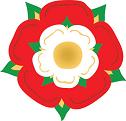
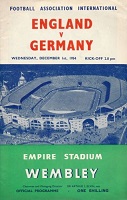 effort to use any FA or
England branding, if any, indeed, existed.
effort to use any FA or
England branding, if any, indeed, existed.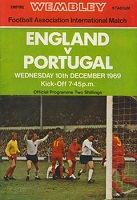 we were now indulged with the emblem again (for some games). These programmes were all 6x9 inches, but in December 1968, a
larger size (6.75x10 inches) was introduced, and a great opportunity to
double the price to two shillings! Strangely for a game against Bulgaria,
there was an action shot from Manchester United's European Cup victory in
the same stadium from seven months earlier, on the cover. In May 1969,
with the annual British Championship becoming an eight-day tournament, the
programme for the deciding game against Scotland was extended to twenty
pages.
we were now indulged with the emblem again (for some games). These programmes were all 6x9 inches, but in December 1968, a
larger size (6.75x10 inches) was introduced, and a great opportunity to
double the price to two shillings! Strangely for a game against Bulgaria,
there was an action shot from Manchester United's European Cup victory in
the same stadium from seven months earlier, on the cover. In May 1969,
with the annual British Championship becoming an eight-day tournament, the
programme for the deciding game against Scotland was extended to twenty
pages.
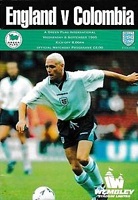 Wembley resumed its publication of the England programme for the
1995-96 season, re-establishing a rather large logo on the cover, but now
the Three Lions emblem was also prominent and would continue to be so,
having been supplemented with a registered trademark and the team name
underneath (this version was to be introduced for the new indigo-blue
change shirt in 1996). It was back to 52 pages, but the price went back up
to £4.
The
next two programme covers in that season featured 8cm-tall ENGLAND
lettering printed side-on down the right-hand side, but the three
following that, dropped the team name from beneath the emblem.
Wembley resumed its publication of the England programme for the
1995-96 season, re-establishing a rather large logo on the cover, but now
the Three Lions emblem was also prominent and would continue to be so,
having been supplemented with a registered trademark and the team name
underneath (this version was to be introduced for the new indigo-blue
change shirt in 1996). It was back to 52 pages, but the price went back up
to £4.
The
next two programme covers in that season featured 8cm-tall ENGLAND
lettering printed side-on down the right-hand side, but the three
following that, dropped the team name from beneath the emblem. 
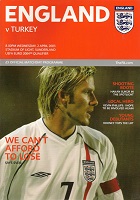 At the beginning of 2002, the style was then tweaked slightly. The
red banner changed to white, with a red border, neatly matching the style
of the England shirt, with its single red stripe.
At the beginning of 2002, the style was then tweaked slightly. The
red banner changed to white, with a red border, neatly matching the style
of the England shirt, with its single red stripe.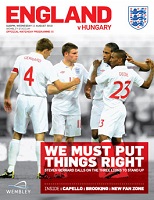 The font was finally changed, after seven years, in 2010, and was
now rendered in red on a white background. Another wallplanner was
included at the beginning of the Euro 2012 qualifying competition and
there was a regular eight-page supplement called 'Get Into Football'
included in each England programme for the next eighteen months, all
featuring articles dedicated to the grassroots game. In order to
accommodate these small-size inserts, the programme dropped the spine and
reverted to staples again. The main magazine dropped back to 68 pages
at the end of 2010, still at £6.
The font was finally changed, after seven years, in 2010, and was
now rendered in red on a white background. Another wallplanner was
included at the beginning of the Euro 2012 qualifying competition and
there was a regular eight-page supplement called 'Get Into Football'
included in each England programme for the next eighteen months, all
featuring articles dedicated to the grassroots game. In order to
accommodate these small-size inserts, the programme dropped the spine and
reverted to staples again. The main magazine dropped back to 68 pages
at the end of 2010, still at £6.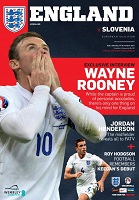
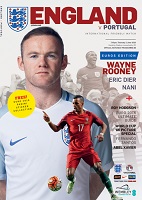 Wembley introduced its own sponsor (EE) to the cover in 2014, but
it was the second game of the 2014-15 season when we saw the next big
change.
Wembley introduced its own sponsor (EE) to the cover in 2014, but
it was the second game of the 2014-15 season when we saw the next big
change. 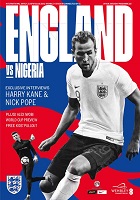 From 2018, the publication
dropped in price to £5 for the first time since 2007. It switched back to a simple 'paper and
card' material, with a reduced 68 pages, and it was printed in Merthyr
Tydfil in Wales. A dramatic new design was
introduced in red and blue, with the cover stars in black-and-white, and
'ENGLAND' in a very elongated font, behind the cover star (the social media
tags were re-positioned onto the spine). Meanwhile, Vauxhall were no
longer sponsoring the England Supporters Club which had a new logo on
the back cover. There was also a new small eight-page insert for younger
fans called 'Junior Lions' which ran for six editions, before becoming a
part of the main programme as '#Junior Lions: Kids Zone', up until 2022, though reduced to three or four pages.
From 2018, the publication
dropped in price to £5 for the first time since 2007. It switched back to a simple 'paper and
card' material, with a reduced 68 pages, and it was printed in Merthyr
Tydfil in Wales. A dramatic new design was
introduced in red and blue, with the cover stars in black-and-white, and
'ENGLAND' in a very elongated font, behind the cover star (the social media
tags were re-positioned onto the spine). Meanwhile, Vauxhall were no
longer sponsoring the England Supporters Club which had a new logo on
the back cover. There was also a new small eight-page insert for younger
fans called 'Junior Lions' which ran for six editions, before becoming a
part of the main programme as '#Junior Lions: Kids Zone', up until 2022, though reduced to three or four pages.